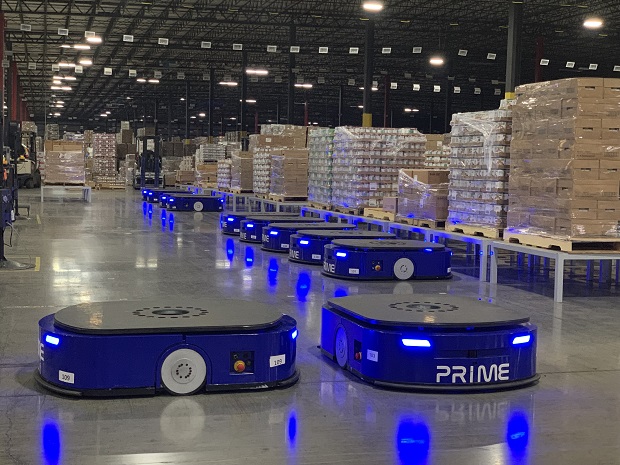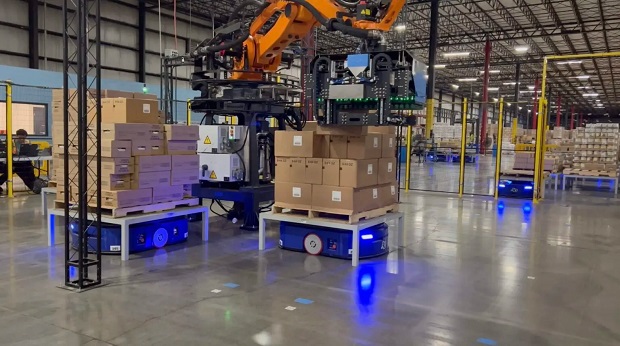Orders stack up, labour stays tight and the same bottlenecks keep stealing your shift. Overtime covers the gap for a night, but then faults pop up again. You need steady flow, safer work and clearer control that you can see on the floor.
 Full-service automation brings robots, software and one accountable partner together to pull in the same direction. They map the process, connect the kit to the control system and keep it running. Start small, fix the worst choke point, prove the gain, then scale. Are you prepared to make that move?
Full-service automation brings robots, software and one accountable partner together to pull in the same direction. They map the process, connect the kit to the control system and keep it running. Start small, fix the worst choke point, prove the gain, then scale. Are you prepared to make that move?
 What Is Full-Service Warehouse Automation?
What Is Full-Service Warehouse Automation?
Full-service means one accountable team takes you from design to run. It maps your process, aligns hardware to real demand and stitches everything into real-time decision-making software.
Most stacks sit on four layers. Autonomous mobile robots (AMRs) and automated guided vehicles (AGVs) move pallets and totes. Conveyor, sortation and shuttles handle routing. A warehouse execution system (WES) directs work based on priorities and constraints. Warehouse management systems (WMS) and enterprise resource planning (ERP) handle inventory, orders and finance.
When these layers talk cleanly, picks arrive when needed, lifts avoid blind runs and pack lines stay fed.
The right provider designs safety into the flow. Traffic management slows zones, reroutes paths and blocks unsafe moves. Good stacks protect networks with role-based access and encrypted links. You also get dashboards that track throughput, dwell and downtime by cause, so supervisors can fix issues before they grow.
Top 7 Global Warehouse Automation Companies
Seven firms are worth watching if you run a busy site and need results. Each one brings different strengths — software brains, high-speed storage or rock-solid service — so you can benchmark what fits your flow and budget. Use these snapshots to spot partners that keep shifts steady and orders going out the door on time.
1. Arnold Machinery
Arnold Machinery designs and installs the full setup, from lift trucks to storage to software. One team oversees service and parts, which keeps uptime high. This is a good fit if you want one partner to call when something stops.
2. Dematic
Demantic builds fast AS/RS and strong WES/WMS that release work when the line is ready. Its tools model changes before you buy, so you avoid surprises. It suits high-volume sites that can’t afford bottlenecks.
3. Daifuku Co.
Daifuku Co. is known for big shuttle and rack systems that move pallets and totes with tight control. It tunes flows to match takt time on the factory floor. Choose Daifuku when you need stable, repeatable moves shift after shift.
4. Honeywell Intelligrated
Honeywell Intelligrated combines sorters, voice and WES to keep peaks under control. Dashboards show labour needs and faults in plain view, so leaders can fix issues fast. It’s a solid choice for sites that spike during promotions or holidays.
5. KNAPP AG
KNAPP AG delivers goods-to-person systems that cut walking and touches. AI guides pick and check quality, which improves accuracy. It is trusted in health care and retail, where mistakes cost time and money.
6. Fortna
Fortna plans the job, builds it and runs it with clear service level agreements (SLAs). Its WES and robotics handle changing order profiles throughout the year. It works well for multisite networks that need the same playbook across buildings.
7. Swisslog
Swisslog integrates AutoStore and pallet solutions with simple, live dashboards. Its service teams focus on uptime, not paperwork. This makes Swisslog a strong option for U.K. grocery and e-commerce, where cut-off times rule the day.
Knowing these major players helps you set targets, write stronger requests for proposals and secure support that matches your footprint.
The Top Benefits of Going Autonomous
Autonomous flows lift throughput and keep it steady across peaks. Royal Mail hit 90% automation in parcel operations after sustained investment, which tightened service and reduced manual touch points across the network. That level of mechanised sortation and software control stabilises daily output and trims rework when volumes spike.
Safety improves when systems engineers eliminate risky moves. From 2023 to 2024, Great Britain recorded 604,000 self-reported nonfatal work injuries. Sites that add traffic management, machine-guarded zones and automated induction require fewer blind lifts and awkward reaches, cutting incidents during busy windows. Supervisors act faster because dashboards show faults and blocked lanes in real time.
Return on investment improves when software and machines clear bottlenecks. Asda doubled picking rates with an AutoStore setup that scaled in phases while the site stayed live, proving that modular automation keeps service steady during change. Many U.K. parcel and retail operators now run full programs — not pilots — using automation to protect SLAs when hiring falls short or absences rise.
Lead time tightens as orchestration smooths handoffs between storage, picking and packing. High-speed sorters and goods-to-person stations reduce travel and idle time, while WES releases work only when downstream capacity can take it.
That coordination lowers overtime, evens shift performance, and makes cut-off times easier to hit during promotions or seasonal surges. Recent industry coverage shows more companies like Marks and Spencer expanding automated hubs and distribution centres to lock in those gains across regions, not just at a single flagship site.
The combined effect looks simple on the floor — fewer stoppages, cleaner traffic and steadier lines per hour. Crews spend less time firefighting and more time running to plan, while maintenance teams work from clear alarms and spares lists. That daily consistency builds the business case every shift.
Common Myths and Misconceptions on Autonomous Warehousing
Myths slow projects more than price or hardware. Clear them early so crews know what changes to expect and why.
Myth: Automation Replaces All Jobs
Automation shifts work. Teams still need technicians to pick leads and traffic coordinators, while systems take on the heaviest and most repetitive tasks. People move into higher-skill checks, repairs and flow control.
Myth: Automation Is Only For Big Companies
Modular tools start small. A compact grid or a few AMRs can launch one zone, then expand without shutting the building. That path lets managers prove the case and train the crew as they scale.
Myth: It’s Too Expensive to Implement
Phased rollouts spread the cost. Each step funds the next through fewer errors, faster picks, and lower injury risk across parcel and retail sites. Vendors also offer service plans and financing that align spend to value.
What to Consider Before Making the Leap
Start with your bottlenecks. Do totes queue at induction, or do pack lanes choke near label print? Map delays by hour and SKU family. Decide if you need faster storage and retrieval, smarter task release or a dock flow redesign.
Check your backbone. Your network must support real-time device traffic. APIs between WMS, ERP and WES must stay stable. A WES layer can buffer and normalise signals if the data gets messy.
Bring the crew in early. Train team leaders to understand slotting rules and release logic so they can tune settings after go-live. Align procedures to Health and Safety Executive guidance and your permit-to-work rules to keep maintenance safe and quick.
Lock the business case. Track the baseline units per hour (UPH), lines per labour hour, order cycle time and lost-time incidents. Set target ranges — not single numbers. Agree on what “done” means for phase one, so success stays clear.
Steps to Get Started With Automation
Use this practical path to move from talk to action:
- Run a targeted pilot: Pick one constrained zone. Measure UPH, dwell, and fault rate before and after.
- Pick the right partner: Shortlist two vendors that integrate hardware plus WES/WMS with on-site support.
- Design for scale: Add spare ports, power and network to expand without rework.
- Measure and iterate: Review weekly data and ship small changes to lock in gains.
Where Full-Service Warehouse Automation Services Fit
You choose full-service warehouse automation services when you want one plan from concept to uptime. This model suits multibuilding networks that need common software with local rules. You keep one playbook for spares, remote monitoring and updates, then tune each site to its mix.
Market signals point the same way. In a 2025 outlook survey, 64% of companies said they plan to invest in automation and technology, 55% in forklifts and lift trucks, 36% in storage equipment, and 32% in information systems such as WMS and ERP. Those choices line up with the hardware-plus-software blend that drives stable performance.
The Future-Proof Warehouse — Trends to Watch
AI moves from pilot to day-to-day. U.K. grocery and parcel operators tie computer vision and predictive analytics to real-time tasking so crews work with fewer exceptions and more planned moves. Financial updates and news coverage show a continued push toward automated sites, even while firms adjust their headcount to hit cash flow goals.
Integration also gets deeper. WES talks to ERP and transport systems to smooth yard slots and dock turns. National parcel networks that reached high automation prove how data and machines scale together.
Take a Clear First Step to Autonomous Warehousing
You don’t need a rebuild to succeed in this transition. Fix the worst pain first, measure the gains and then scale the parts that work. Choose a partner that handles design, software and service so you’re not chasing vendors. When people, kit and code pull together, shifts run cleaner and safer — and customers definitely see the difference.




Comments are closed.